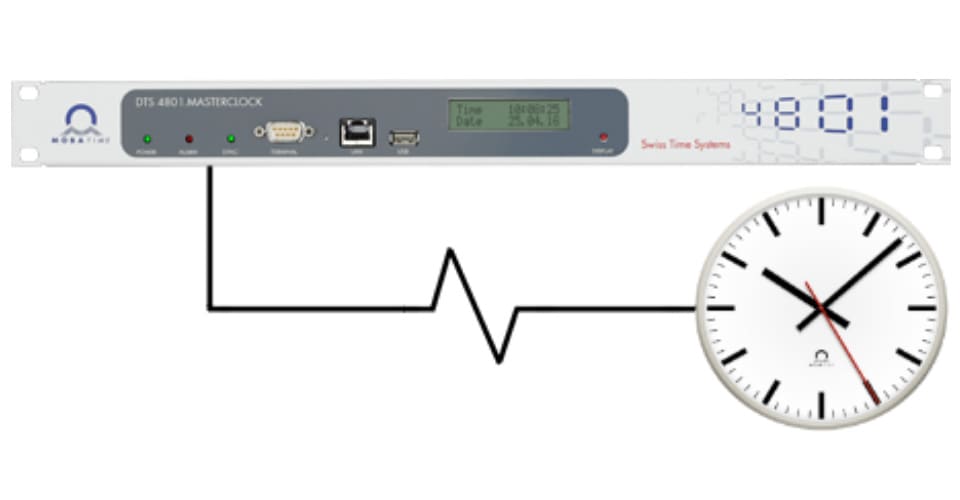There are different timecodes to synchronise clocks. In this article we will look at the most commonly used two-wire timecodes. It will be explained how the timecodes works and what the advantages are. The following timecodes belong to this category:
- Impulse – conventional
- IRIG-B /AFNOR – self-setting
- DCF active – self-setting
- MOBALine -self-setting
Impulse – conventional
How impulse time system works?
Impulse is a conventional two-wired system carrying polarized impulses 12 V, 24V or 48 V.
This conventional two wired time distribution system, has been in use for decades, the control is carried out via pole-changing impulse. A 1-minute, ½-minute or 1-second impulse, transmitted via two-wire lines. Only time can be synchronized (on digital clocks date has to be set manually).
The impulse slave clocks typically have no intelligence in itself and are purely driven using stepping mechanisms. Therefore, self-adjusting feature under impulse timecode is hardly feasible, however running reserve possible via the master clock. Moreover such clocks have to be adjusted manually during startup or after power break so little maintenance intensive.
What are the advantages of such an Impulse time system?
- Simple installation, 2-wire cables such as the telephone cable are sufficient
- Provide the synchronization time and power for the analogue clock hand movement
- Low purchase costs
Important to note:
- Only time can be synchronized, especially for the case of digital clocks where date has to be set manually.
- Impulse system is a less expensive technology to implement but much can be more complicate and expensive for re-commissioning and maintenance.
IRIG-B / AFNOR – self-setting
How IRIG-B / AFNOR time system works?
AFNOR / IRIG (Inter-range instrumentation group timecodes, commonly known as IRIG timecode) is a self-setting, two-wired system. IRIG-B is typically distributed as a DC level shift, pulse-width coded signal (“unmodulated IRIG-B”) or as an amplitude-modulated signal based on a sine wave carrier with a frequency of 1kHz (“modulated IRIG-B”)
The IRIG / AFNOR time protocol is widely used by electric utilities, industrials, and others to ensure precise time synchronization of power system devices, as well as clocks over a large distance of several hundreds or thousands of meters. Unmodulated is much more precise than modulated signal.
Continuous Time code signal without a voltage so external power supply needed to drive the clock mechanism. Time and date code is available for one single time zone function.
What are the advantages of such an IRIG / AFNOR time system?
- Self-setting clocks
- Fast time synchronization comparing to impulses upon return of power after a power failure
- less expensive technology to implement
Important to note:
- The time setting using the IRIG / AFNOR serial coded line takes place slightly longer than other self-setting timecode.
- IRIG / AFNOR time system can be considered as a less expensive technology to implement but can be much more complicate and expensive for maintenance being unidirectional code that does not allow centralized supervision & maintenance.
DCF active – self-setting
How DCF Active time system works?
DCF active is a self-setting, two-wired timecode system. DCF active is a digital timecode carrying 24-28 DC polarized Voltage (depending on power supply).
DCF active is self-aligning timecode for synchronizing clocks over a long distance of several hundreds of meters.
Continuous Time code signal with voltage capable to drive the clock (movement) mechanism. Time and date code is available for one single time zone function. Polarity is not important for time distribution.
What are the advantages of the DCF active time code?
- Simple installation, 2-wire cables such as the telephone cable are sufficient
- Self-setting time code and Provide the synchronization time and power for the analogue clock hand movement
- Low purchase costs
Important to note:
- Time & date setting using the DCF Active line takes place slightly longer than other self-setting timecode.
- DCF Active time system can be considered as a less expensive technology to implement but can be a little complicate and expensive for maintenance being unidirectional code that does not allow centralized supervision & maintenance.
MOBALine -self-setting
How MOBALine self-setting time system works?
MOBALine is a self-setting two-wired time code system, carrying power & data with a 10 – 20 V AC signal. It is a self-setting, self-aligning, reliable timecode, available with features like running reserve provided by the master clock (if equipped with batteries) and error recognition.
MOBALine is a very fast time synchronization code deployed at thousands of worldwide projects available with functions such as Switching commands and World time functions.
Commands such as Run to 12:00 O’clock position and Run mode continuously, half-minute step, minute step are possible. Moreover various interfaces are available to synchronize other systems.
What are the advantages of MOBALine self-setting time system?
- Simple & low cost installation, 2-wire cables such as the telephone cable are sufficient to drive clocks over several hundred & thousands of meters.
- Provide the synchronization time and power for the analogue clock hand movement
- Low purchase costs
Important to note:
- A little expensive technology comparing to conventional Impulse time code system but still economic comparing to other self-setting time code systems but much easier and less expensive for commissioning and maintenance.
- Direct centralized monitoring is not available due to non-network running technology.
Check out our LinkedIn or Facebook page and find more exciting topics related to technology, products, projects and news. Furthermore, you can find more information about our technologies and their applications under Solutions.
